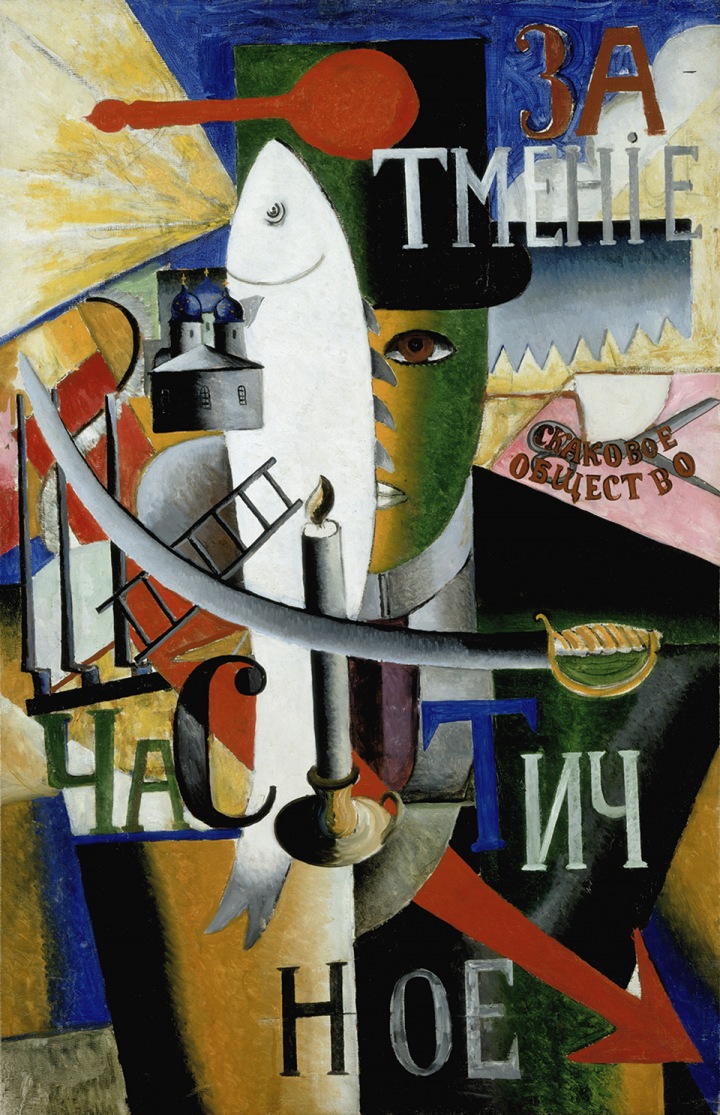Reader question: “Who is the Englishman meant to be in Kazimir Malevich’s 1914 painting An Englishman in Moscow?”
Well this is quite rare: a question focusing on just a single painting! A painting that, the more you look into it, makes you want to slam your head against the desk and yell “WHAT DOES IT ALL MEAN?”
An Englishman in Moscow is a painting by Russian artist Kazimir Malevich, who is perhaps most famous for his involvement in the Suprematist art movement, a movement of abstract art that focused geometric shapes. In fact, he founded the movement and introduced it to the public in 1915.
An Englishman in Moscow was completed in 1914, and while it’s not purely abstract like Malevich’s later Suprematist works, there is a clear focus on abstraction and geometric shapes in it. The painting is also filled with text and symbols: a fish, a scimitar, a candle, a ladder, a white fish, a red arrow, and a red spoon, to name a few. There are fragments of Russian words, too: “partial” and “solar eclipse”.
This collage of objects and words could be completely unrelated, or perhaps they all mean something. Or perhaps they are supposed to make it seem as though they mean something? It’s honestly hard to say and there is no clear consensus that I could find. But returning to the central question being asked here: who is the man standing at the centre of all of these objects? Is this the Englishman?
Art critic Edwin Mullins, writing and narrating for the Stedelijk Museum where the work is currently located, suggests that Malevich is telling the story of an Englishman’s journey through Moscow. In this case, the objects refer to what an Englishman might have noticed about Moscow in 1914, three years before the Russian Revolution. He states that the title “suggests a visual scrapbook of things observed by this foreigner’s eye”. In this context, we can “read” some of the objects in the image. The fragmented and jumbled words make sense when observed by someone who doesn’t understand the language, for example. The scimitar is Russian in style, and could be something noticed as exotic by a foreigner. The small scene of Moscow next to the fish is almost like a postcard image. The red spoon, meanwhile, seems to be a reference to the red wooden spoon that Malevich wore like a brooch in February 1914, identifying as a Futurist artist.
But other objects can’t be explained to easily, as Mullins points out: why would an Englishman in Moscow notice a white fish or a lit candle? Tate’s description of the work states that “The picture suggests the elements of a complex riddle without a solution.” In addition to being inspired by Cubist collage, Malevich could also have been inspired by his contemporary Giorgio de Chirico’s method of juxtaposing seemingly unconnected objects.
I actually reached out to the Stedelijk Museum to ask this question directly: who is the Englishman in the painting? Thank you to Michiel Nijhoff, Head of Library and Archives, who gave me the following answer: “The Englishman is not a specific Englishman but rather a metaphor in the juxtaposition of East and West; city and countryside.”
So, to answer your question: whatever the painting means—whether the objects are completely unrelated, or hold some kind of symbolic meaning—the Englishman in the title seems to be an undefined, nameless, well-dressed Brit, who has come to Moscow and is observing it with a foreign eye.



Leave a Reply